

The Making of and Post-Mortem
By Rostik Fomich
Click these to skip to different sections of the design document.
PART 1: INTRODUCTION
This part of the design document will cover the research, theory, and planning behind Storm Drain.
About the Designer
I have been a level-designer in my personal pursuits for over a decade. Over this time I have picked up a variety of skills and knowledge as it applies to level design. I’ve always been a creative person and deeply passionate about creating things regardless of the medium. One of my first experiences with “level design” was spending countless hours creating levels using the tile based level generator for TimeSplitters 2 (2002). Little did I know this would only be the beginning of my fascination with creating modifications and custom content for video games in the years to come. Other early endeavors included learning Unreal Engine 2 to develop custom levels for America’s Army 2 (2002) and GTKRadiant to develop custom levels for the Quake 2 mod Tremulous (2006).
Due to the similarities between the Quake Engine and the Source Engine, I found myself engrossed with modding when I picked up the Orange Box in 2007. Not only did I find myself with a wealth of new content with which I could use to create new and interesting scenarios, but I also found myself surrounded by dozens of actively developed mods. I took my baby steps with single player level design in Half-Life 2: Episode 2, but found myself gravitating back to my multiplayer roots when I soon picked up Counter-Strike: Source (2004). Over the years I dabbled in creating multiple different single player and multiplayer experiences, but mainly stuck to creating content for multiplayer titles such as Counter-Strike: Source and Counter-Strike: Global Offensive (2012).Throughout my journey I mastered Valve’s development pipeline, including the creation, optimization, and design of levels in Hammer, models and animations in Autodesk 3DS Max, creation of materials in GIMP and Photoshop, v-scripting in Squirrel and Lua, programming in C#, and audio design in Audacity and Ableton Live. Thinking back on my journey, it became clear that many of the design skills I picked up derived from an innate curiosity with creation and the desire to push myself to create new experiences with new mediums. Despite my turbulent life, academic studies, and career, I have always found a way to seek out a creative avenue and keep my passion for creation strong over the years. This design document about Storm Drain is more or less a heartfelt letter to my younger-self, letting him know that all those hours he stayed up honing his craft were worth it.About Storm Drain
Storm Drain is a level I designed and created for Valve Software's release Half-Life: Alyx (2020)(HLA). The level itself is a journey through a drainage canal and its connecting sewers and industrial facilities. It is roughly one hour long and consists of multiple unique puzzles and combat encounters that cannot be found in the original game.
The creation of Storm Drain took place between May 2020 and July 2022. However, there were long stints of inactivity due to my career and personal matters. A brief timeline of the project's development is outlined below:
Development Timeline
May 2020
June 3, 2020:
June 17, 2020:
July 2020 - March 2021:
April 2021:
May 28, 2021:
June 9, 2021:
July 13, 2021:
August 20, 2021:
November 29, 2021:
December 2021 - April 2022:
May 2022:
June 5, 2022:
June 26, 2022:
July 16, 2022:
Active Build Time: 12 Months
Development begins
v.1a
v.2a
Project ceases development
Project resumes development
v.3a
v.4a
v.5a
v.6a
v.7a
Project ceases development
Project resumes development
v.1b
v.2b
Official Release
Overall, the development of Storm Drain has been thoroughly engaging and educational. It has pushed me to learn quickly and understand complex systems that were uniquely developed for HLA and its engine branch. This design document hopes to share my experiences with the creation and development of Storm Drain and all the insights into level design I have taken away from the project.
Intent and Inspiration
Storm Drain initially began as a simple testbed to play with the new features of HLA, Source 2, and Valve’s development tools. As time went on, it was developed into a fully featured level for stand-alone play.
After playing through HLA, I developed a fondness for Valve’s variety of industrial environments presented to the player including construction sites, warehouses, and dark sewers. Because of the wealth of assets created by Valve to support these environments, I knew HLA was distinctly equipped to handle the creation of new industrial environments. Storm Drain began its life as a sewer themed playground to test VR combat and puzzles. As the project grew, Storm Drain drew inspiration from familiar American industrial locations such as the Los Angeles River and the NYC Subway, both of which inspired many of the locations in the completed level. Storm Drain also drew inspiration from canals in the Netherlands, as well as a variety of different industrial locations which revolved around the constriction, management, or processing of water. Below are a handful of source images which were used in the development of Storm Drain.
Sampling of Reference Imagery
Source images like those included above helped Storm Drain develop a distinct tone and setting. Although certain areas of HLA, including the area leading up to the Vortigaunt Hideout and canals, illustrated environments which recently experienced precipitation or drainage runoff, Storm Drain was intended to be an emergency overflow canal which would typically remain dry. As such, it allowed me to explore a familiar environment to HLA, but with a unique twist that presented its own design challenges.
Initial Design Concepts
Overall, I wanted to create a similar to HLA campaign experience which meant emulating Valve’s iconic level design. Below is a brief list of topics which I actively pursued during the development of Storm Drain:
1. Compact, but multi-purpose use of space.
The cornerstone of Storm Drain’s design philosophy is its intricate connections of multi-purpose spaces. Storm Drain features many different types of environments, but a commonality between them is the player’s ability to traverse and experience them in multiple ways to complete different objectives.2. An intricate journey through varied 3d environments.
Storm Drain includes many different settings connected through a variety of believable transitions. This includes: canals, sluice gates, runoff drains, control towers, control rooms, water processing plants, industrial facilities, train bridges, and subway cars. I wanted Storm Drain to tell an interesting story of how the player gets from point A to point B, all the while dropping hints as to where the player will find themselves next.3. Guiding the player intuitively to goals.
- Lighting: Lighting was a huge focus during the development of Storm Drain and used extensively to either draw the player’s attention or away from different areas in the environment. Lighting was also used to identify threats such as where combine would enter arenas.
- Color: Color was used in a similar fashion as lighting and mainly served to identify points of interest or interaction to the player. If something is important in Storm Drain, you can assume its likely indicated so by its coloration.
- Details: Details were also used to identify points of interest or interaction during the development of Storm Drain. This meant maintaining a consistent tone throughout the use of details in the level, but also avoiding the use of noisy or extraneous details which would detract the player’s attention away from goals or threats.
- Effects: Effects also bolstered Storm Drain’s ability to intuitively guide the player to their goals. Often effects such as sparks, changes in lighting, material proxies, and scripted sequences are used to specifically call the player’s attention to a goal or threat.
- Sound: Last, but not least, sound is used extensively in Storm Drain to confirm a player’s progress with a puzzle, introduce new environments, make the player aware of threats, and control the rhythm and pace of the player’s progress through the level. Since VR is such a personal experience, sound is extremely effective at engaging the player with tasks or presenting information. Storm Drain also utilizes many of the dialogue options present in HLA to form a cohesive narrative which loosely guides the player on their journey throughout the level.
4. A balanced mixture of combat and puzzles.
Storm Drain was designed with a natural mix of puzzles and combat. This means that the level is neither a slug-fest or an escape-room, but rather a narrative through an environment that requires the player to both think and fight to successfully reach the conclusion of the level.In addition to these overarching design concepts, numerous official maps were studied to understand Valve’s design philosophy, use of assets, and artistic tone. Storm Drain sought to emulate these elements of Valve’s design by using numerous different levels as case studies. Some of the levels in HLA that were most influential to Storm Drain’s design include a2_pistol, a3_processing_plant, and a4_trainyard since each of these environments effectively used the available industrial assets and gameplay motifs established in HLA. In addition to case studies, numerous development levels were created to experiment and play with different aspects of Source 2 and HLA in order to learn the intricacies of new systems, but also to compartmentalize the development of Storm Drain’s most complicated encounters, puzzles, effects, and sequences.
In the coming sections, I will discuss the numerous iterations of the level, the challenges I experienced, and the solutions and skills I learned to overcome them. Storm Drain was a hugely informative project which helped me learn how to become a more effective level designer. That being said, the road to the finish line was far from easy, and many setbacks and difficulties presented themselves during the development of Storm Drain.
PART 2: STARTING OUT
This part of the design document will cover the design of Storm Drain up until its first playtested release.
The Atrium
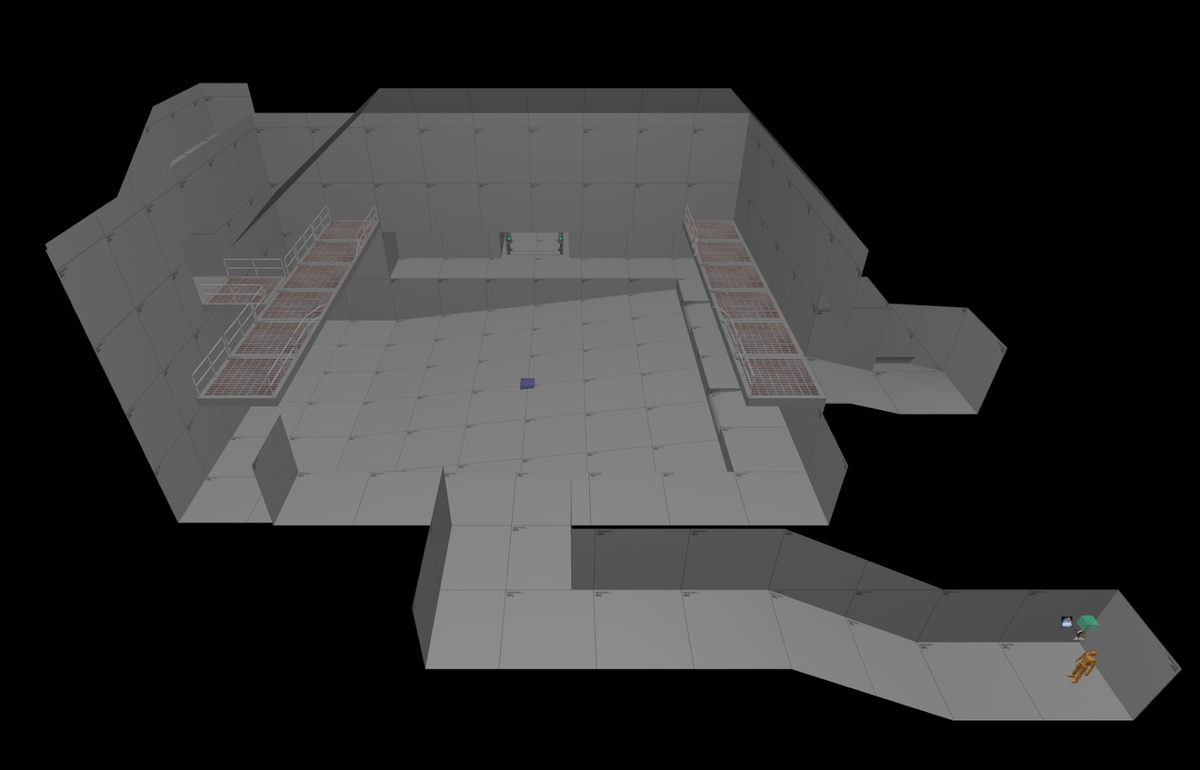
1. Since Storm Drain began as a technical test, the earliest environment was designed as a large room which could facilitate combat experiments. However, even the earliest version of the map includes multiple elements that still remain in the finalized project. Beside is the very first version of the Atrium:
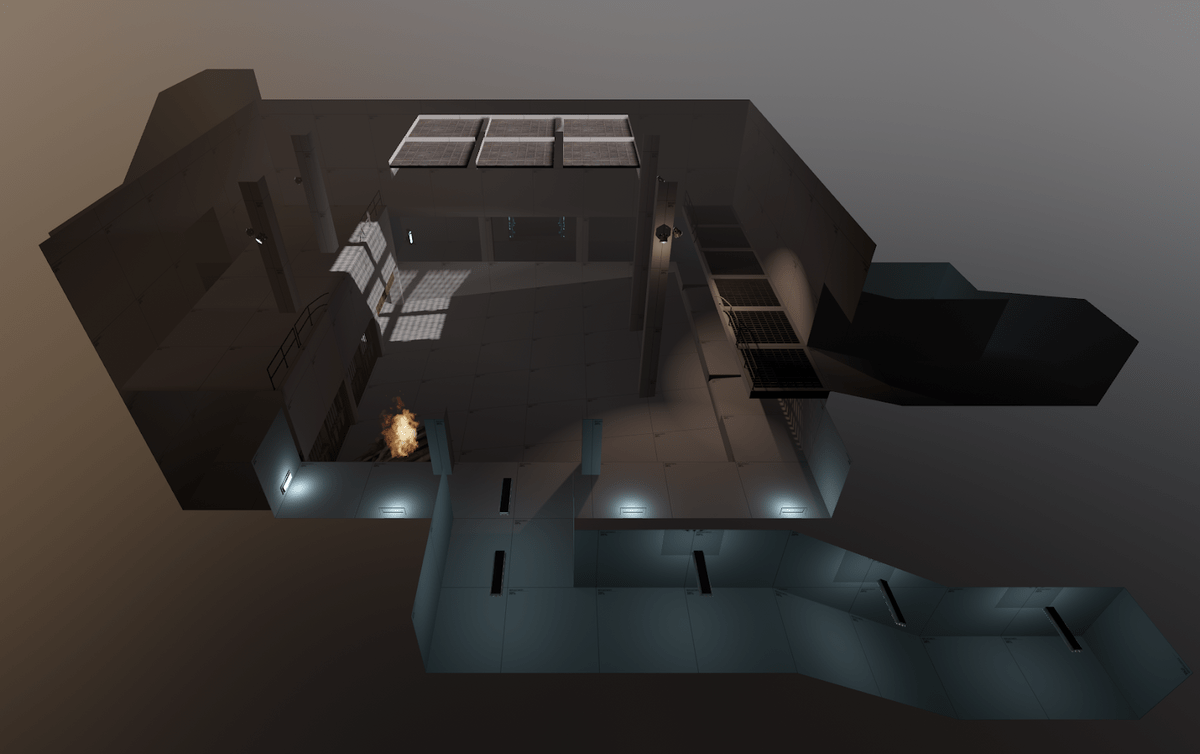
2. From here the atrium was continually developed to include further refinements, which once again largely set the mold for the layout and design of the underground areas of Storm Drain.
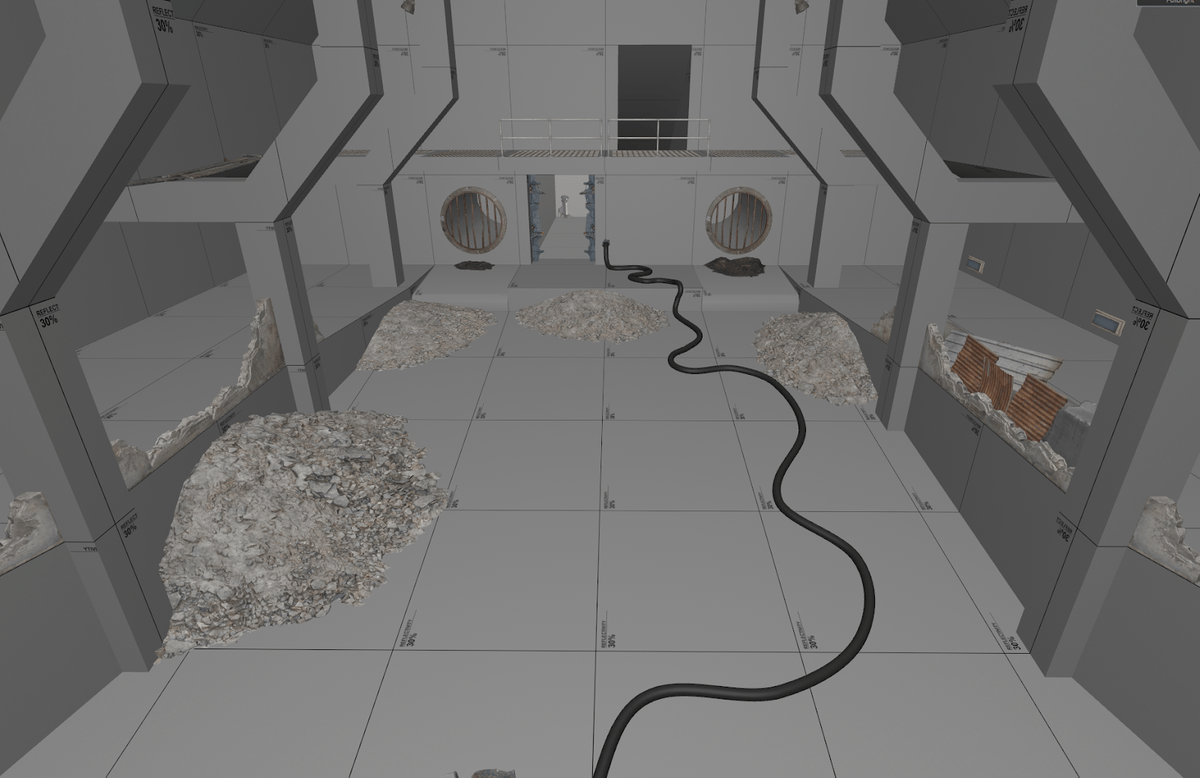
3. As development continued, the shape and details of the Atrium continued to take form. Early additions included the runoff drains, debris piles, and early implementation of cover and columns:
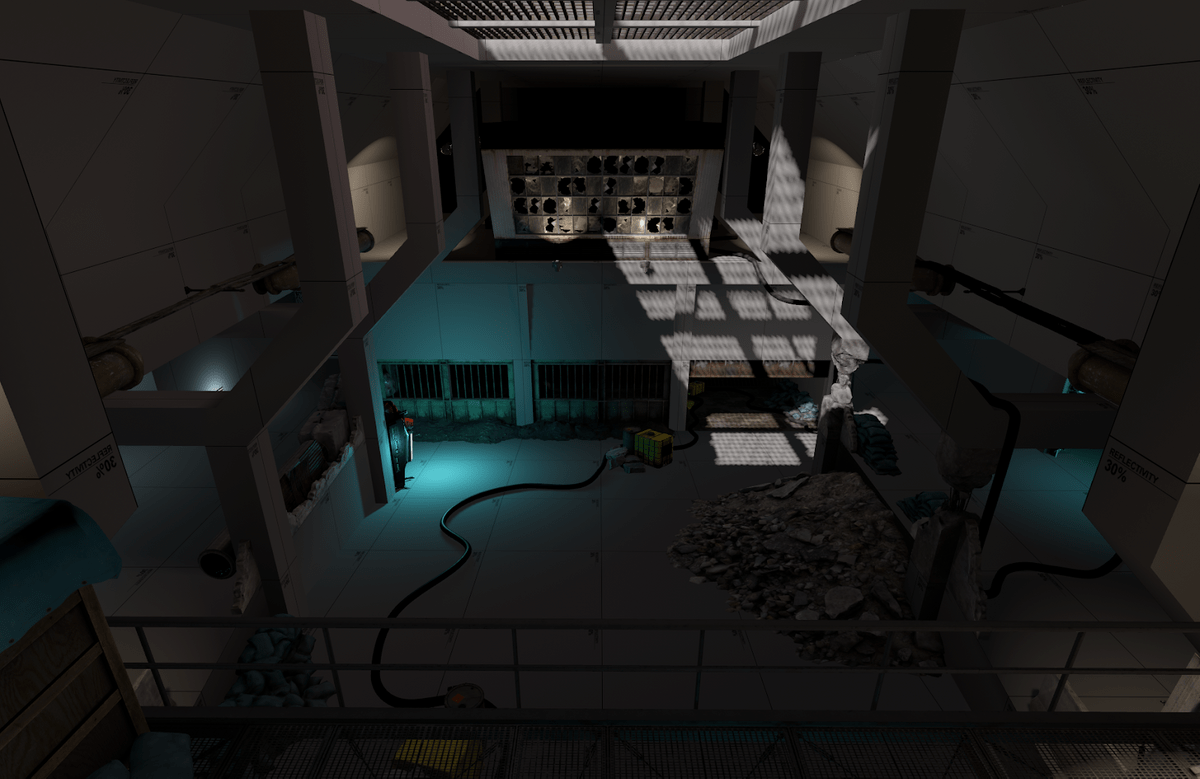
4. In later versions, the Upper Atrium and Control Room began to take form:
The Ramp

1. A defining characteristic of the Atrium is the gradual slope of the Ramp. This quickly developed into a central design concept upon. Beside is a profile of the ramp at a 32x32uu grid size:
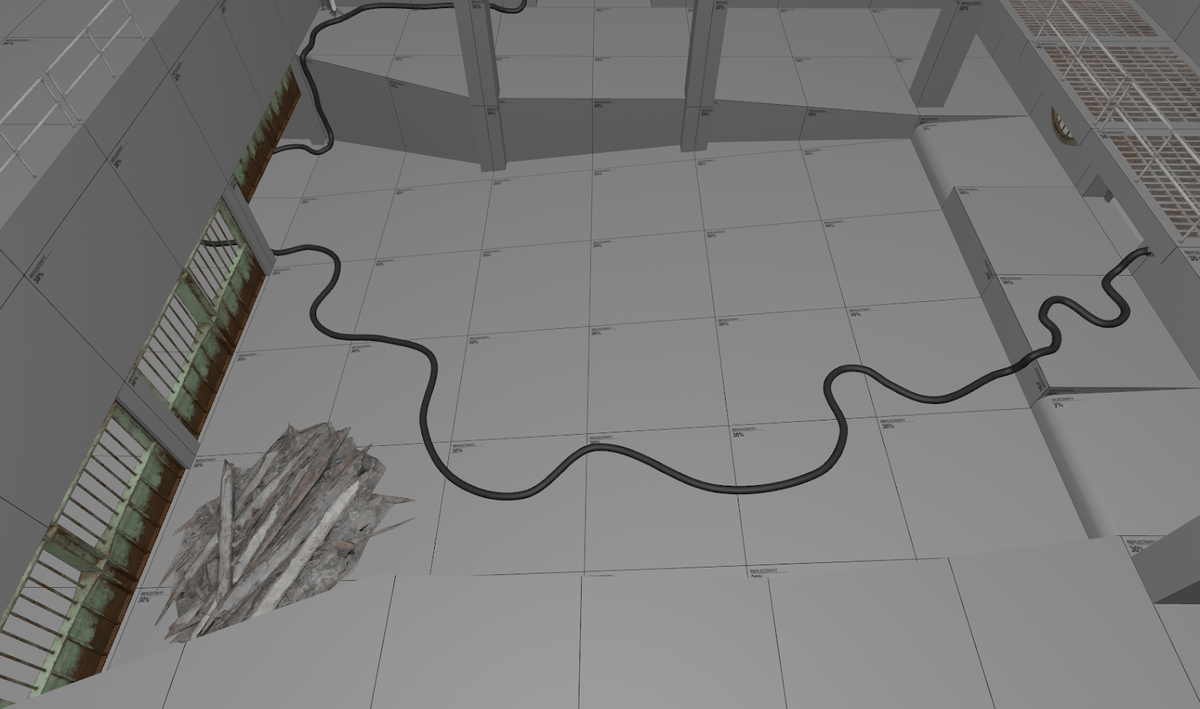
2. Although simple by nature, the ramp provided both a logical explanation as to where the sewer drainage would go, but also a unique opportunity to explore the gradual shift in verticality of the playable space. The ramp also serves as the main connector between the Atrium and the Lower Sewer. As further revisions were made, the ramp continually received attention and modifications which accented its presence in the Atrium even further. Below is an example of the gradual tightening of the Ramp’s width which allowed for more flat space to encompass the atrium:
The Cables and Doors
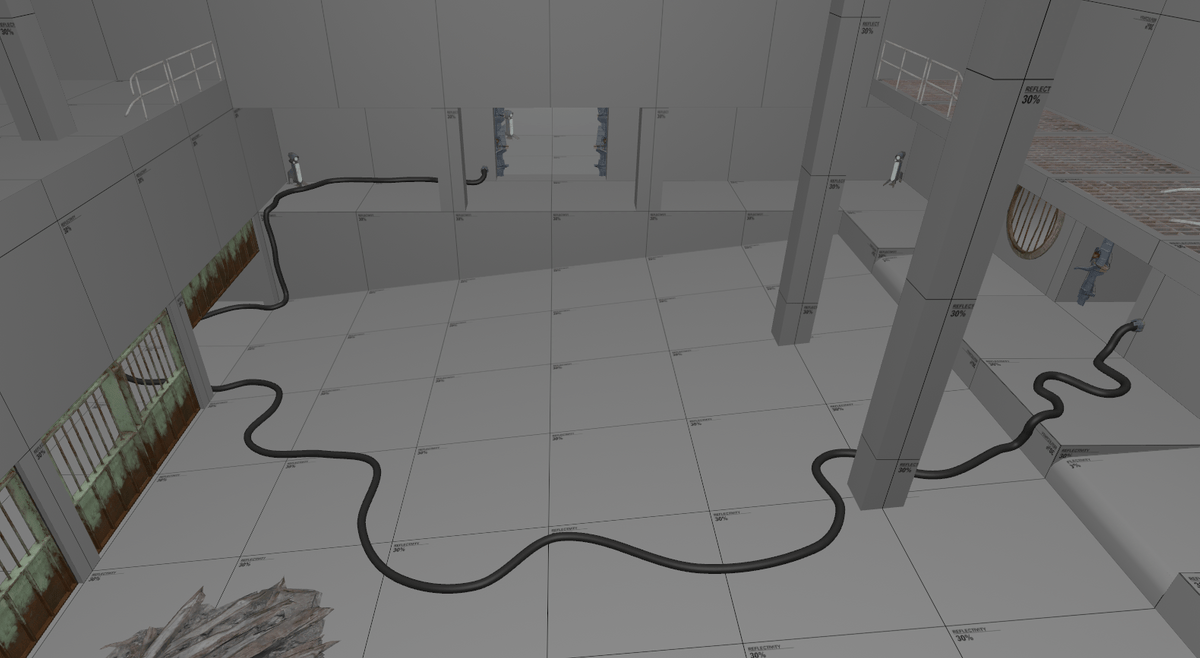
1. The Combine Shield Doors can be seen as early as the very first version of the level. However, the Cables do not make their first appearance until the 11th iteration of the mapfile. Below is the initial inclusion of the Cables which marked the first appearance of a goal for the player, i.e. turn off the power.
The Lower Sewer and First Puzzle
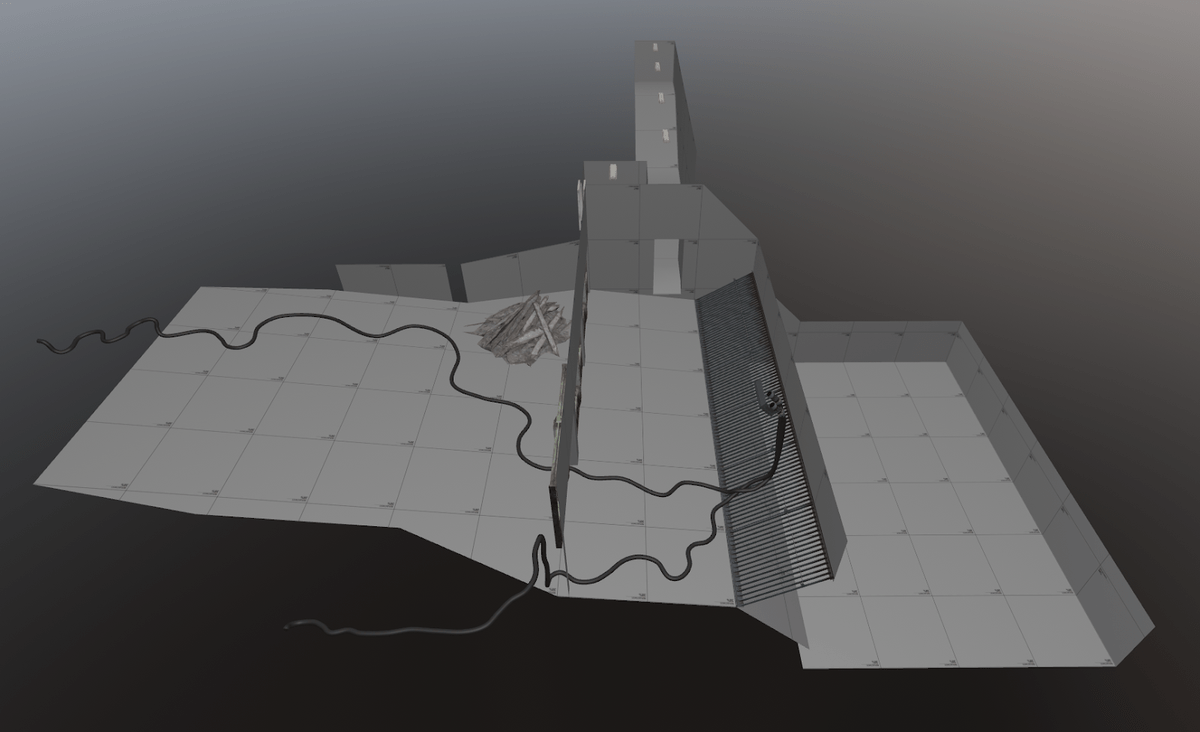
1. The Lower Sewer first appears in the 4th iteration, but really begins to take form in the 17th iteration. Included is a screenshot of the earliest iteration of the Lower Sewer which included an offshoot which would later be developed into the Breaker Box Puzzle:
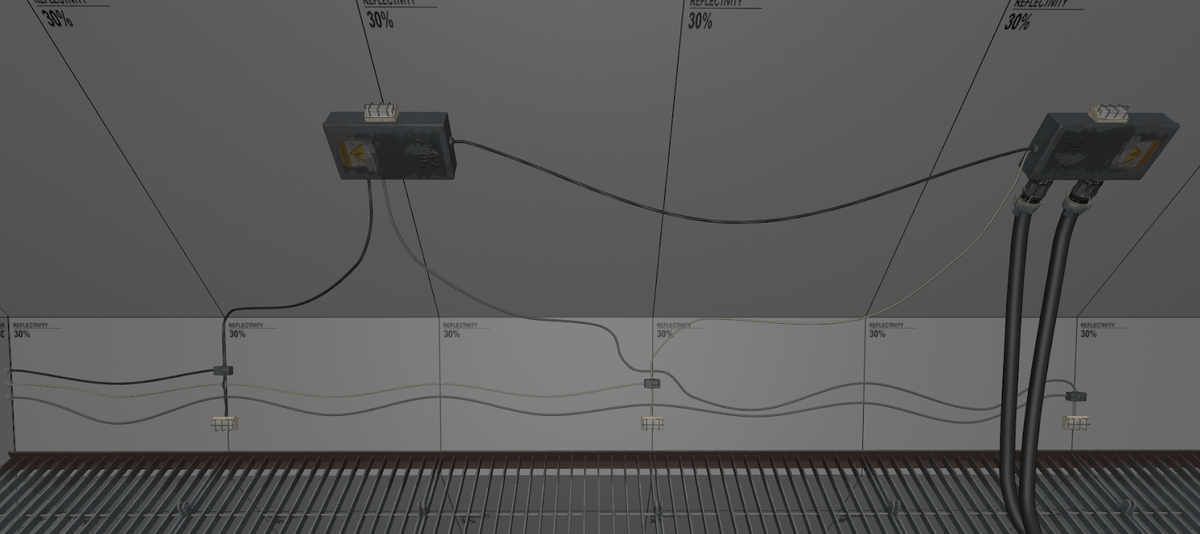
2. By version 20, we can see the beginnings of the Breaker Box Puzzle take its initial form. The puzzle originally consisted of one transformer which needed to be overloaded and one transformer which needed to be turned off. At this stage in the development there was really no way for players to understand this due to the lack of messaging and awkward positioning of the breakers and transformers in relation to each other.
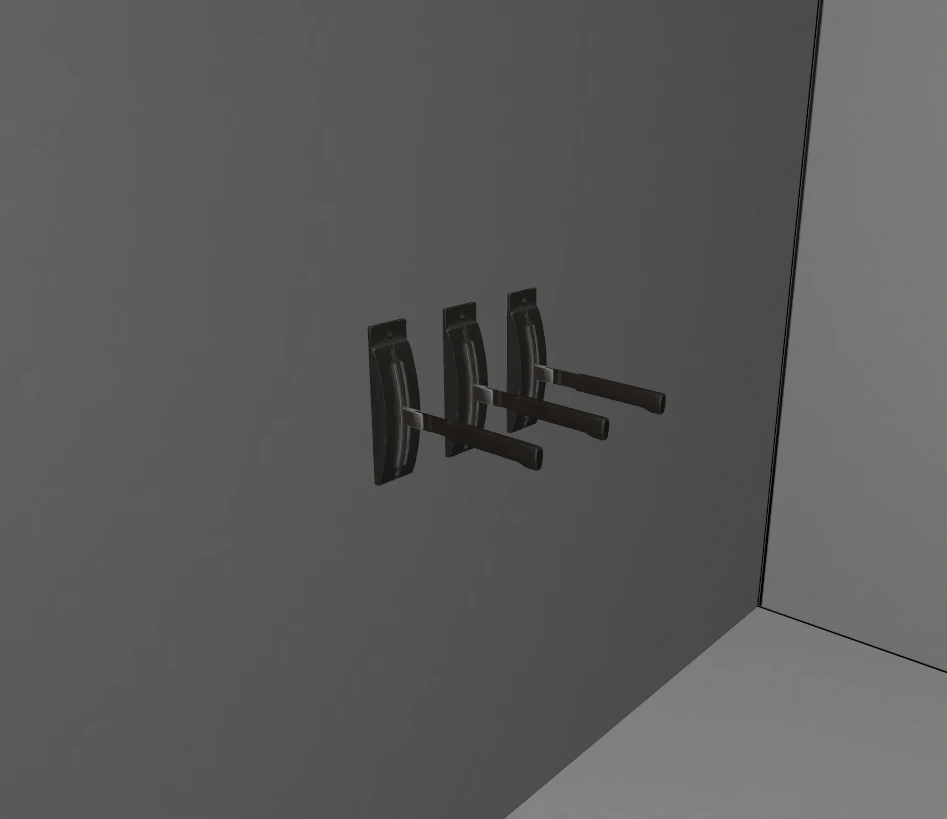
Breakers With Tools Disabled
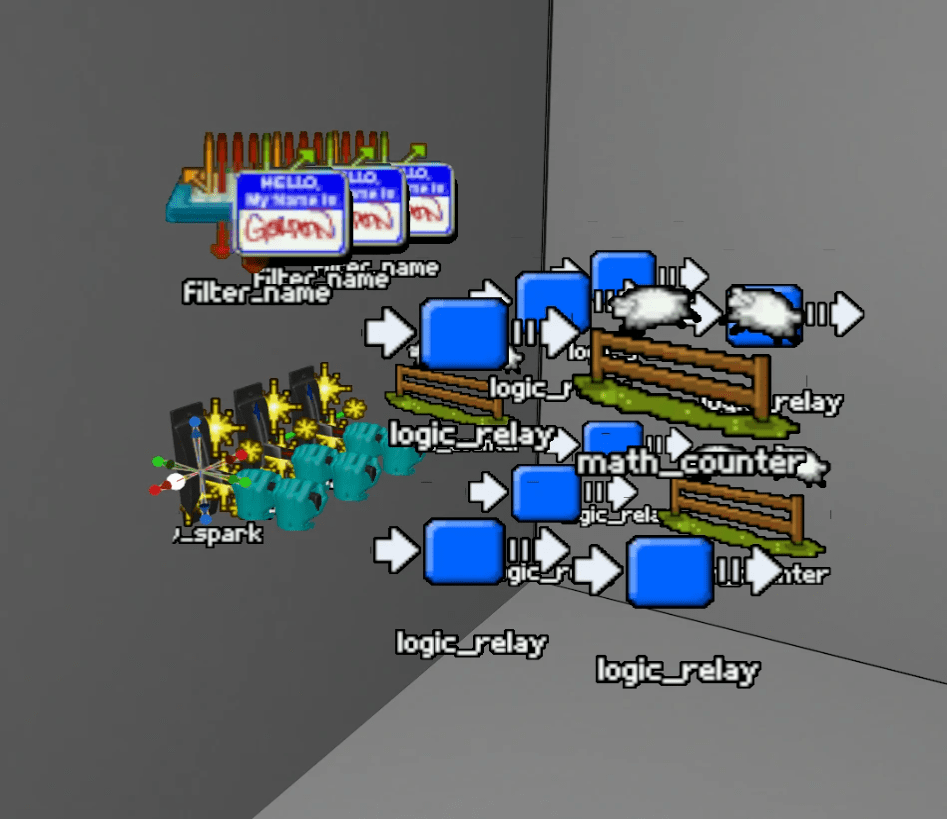
Breakers With Tools Enabled
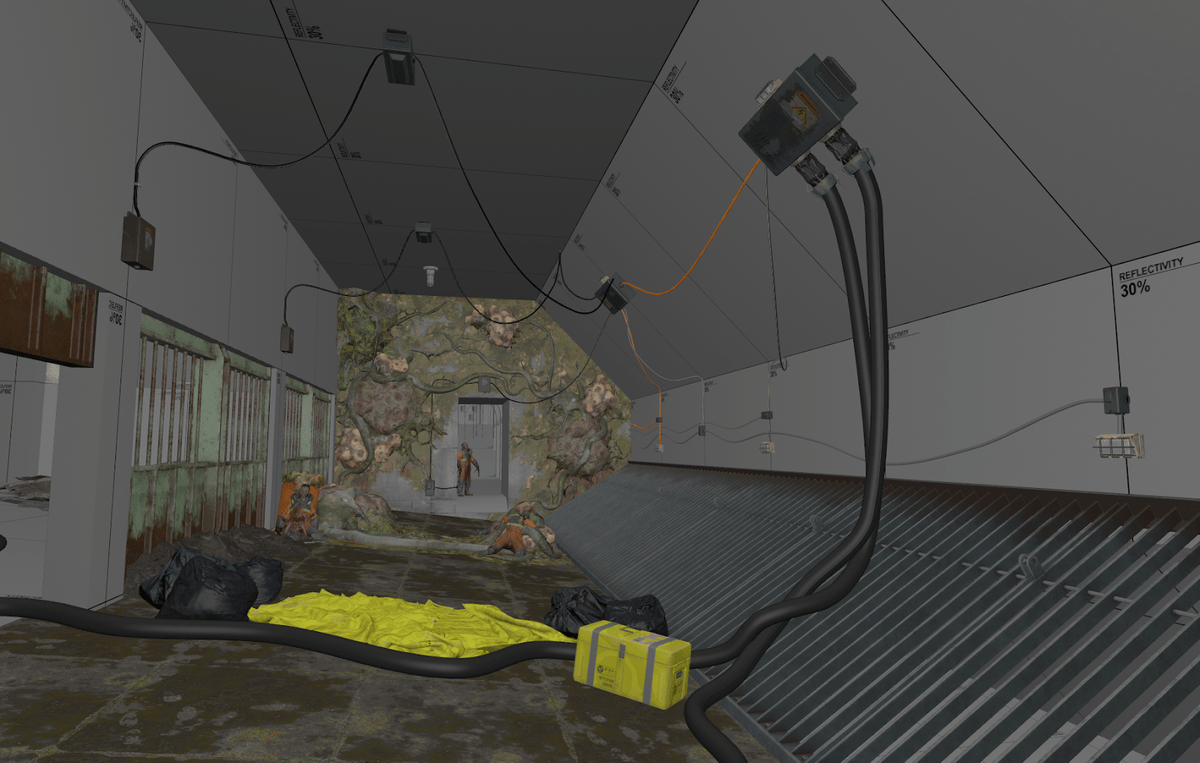
3. By version 25, additional art and gameplay elements are introduced, such as barnacles and zombies to obstruct the player’s progression to the breakers:
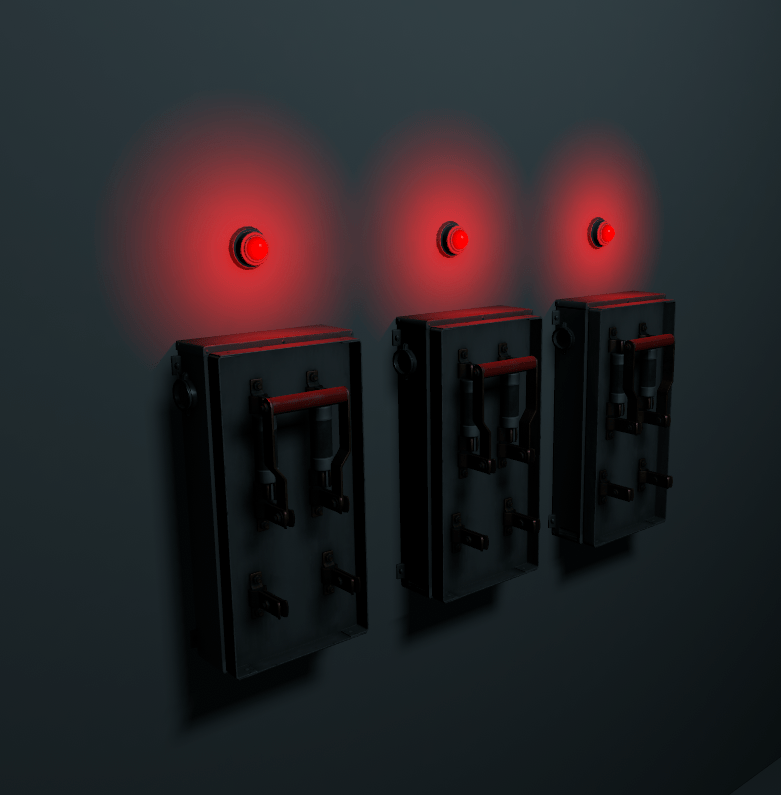
4. By version 28, the breakers are transitioned to prop_animinteractable and lights were added to indicate to the player the status of each breaker:
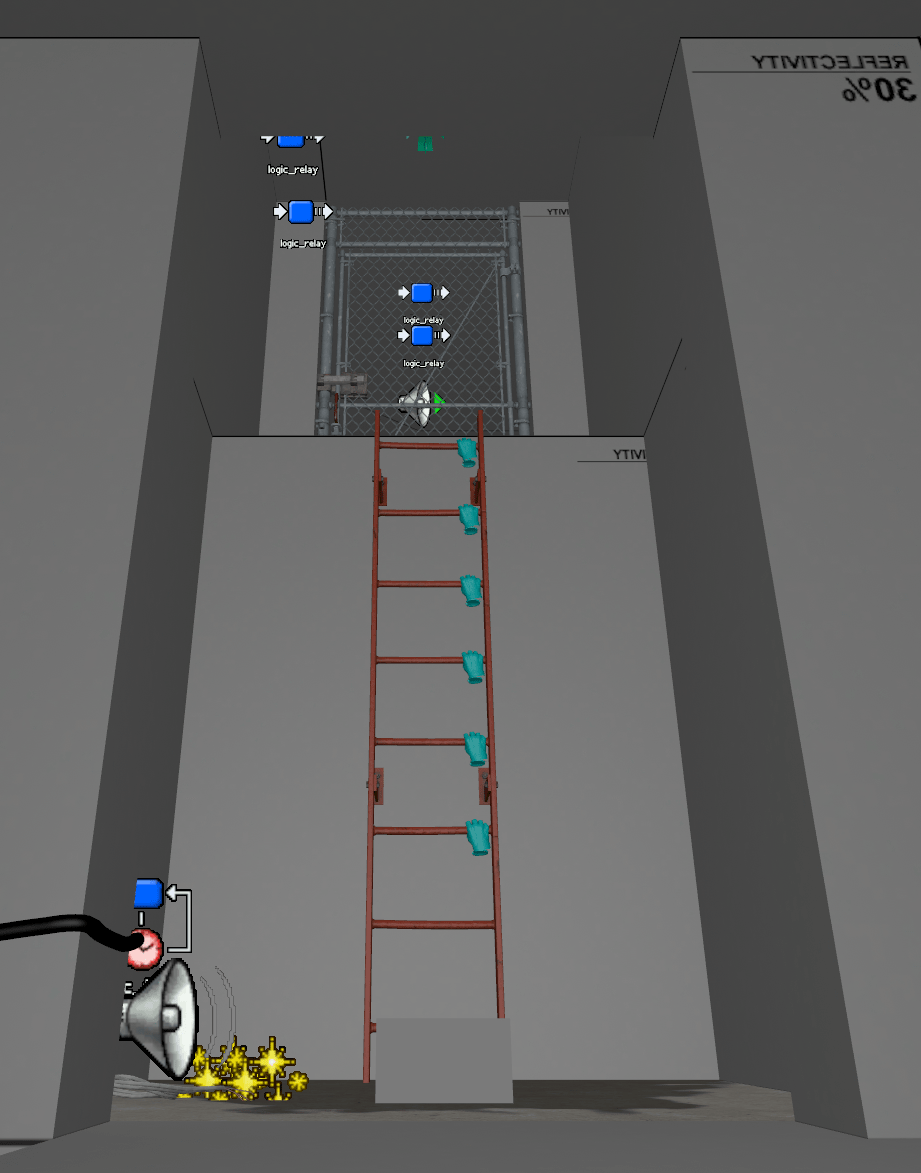
5. By version 31, the exit from the breakers puzzle is implemented.
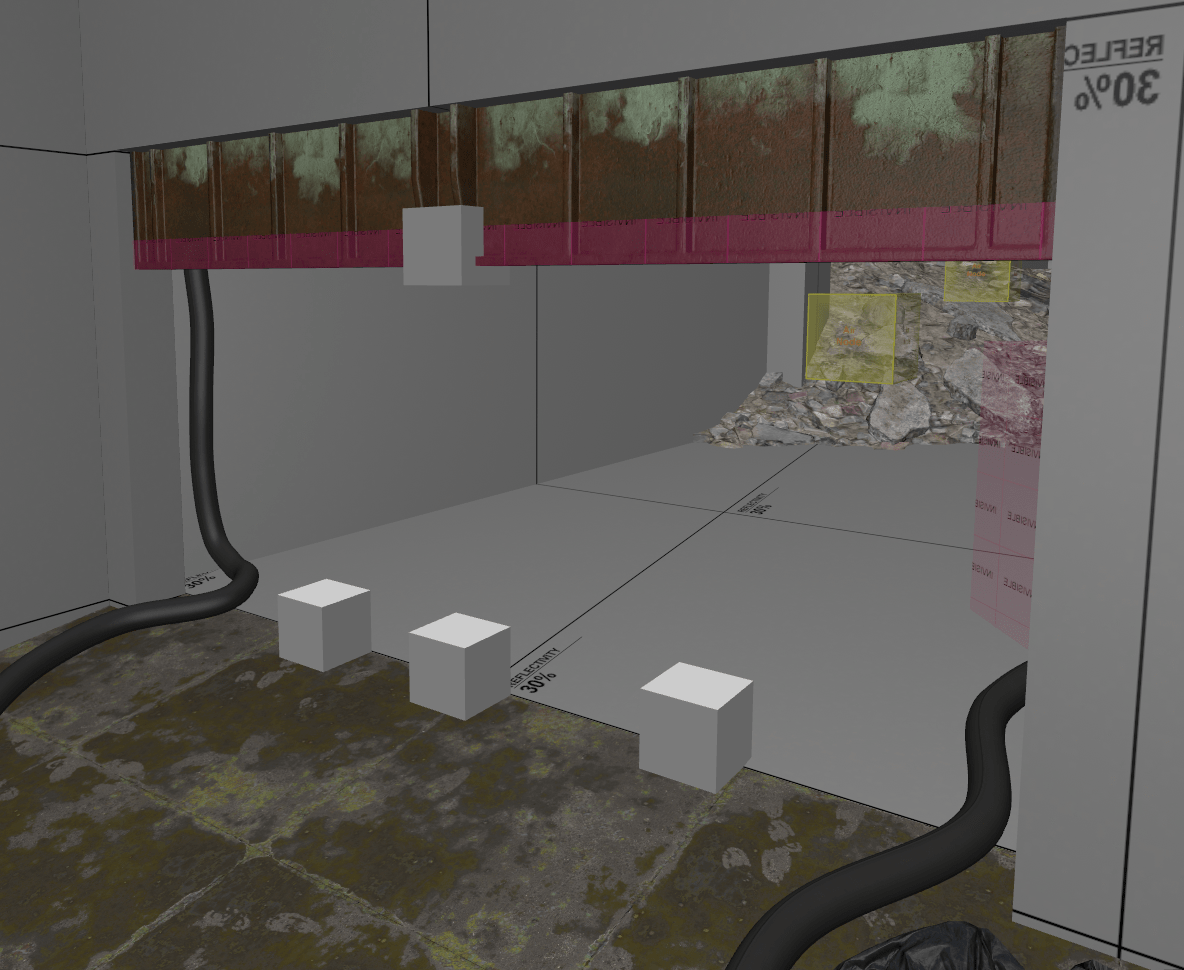
6. Also in version 31, the result of the puzzle prevents the player from returning through the originally open sluice gate.
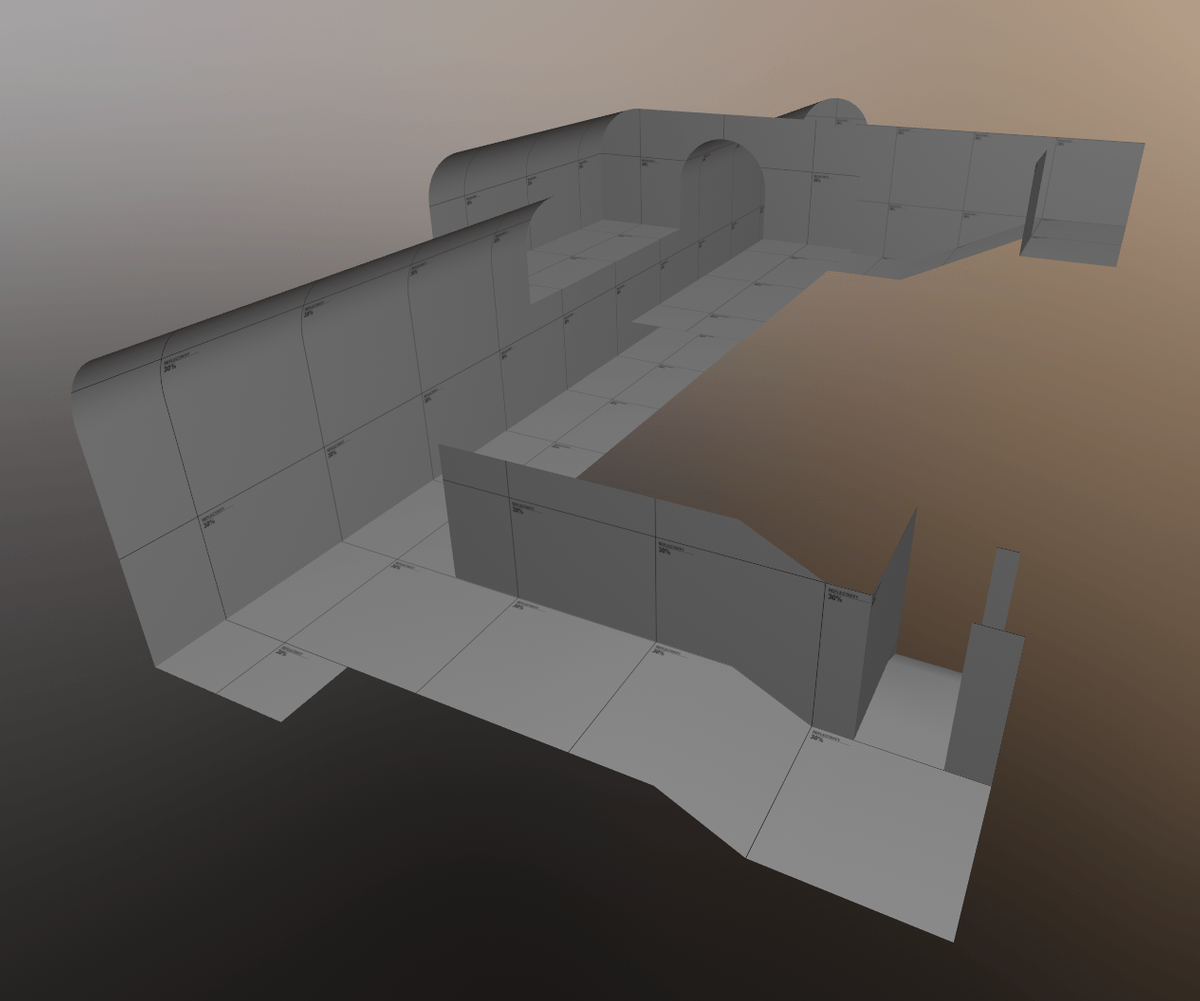
7. By version 37, the lower sewer was expanded to have a section which wrapped around the backside of the drainage area which presented the player with the breakers at an overlook.
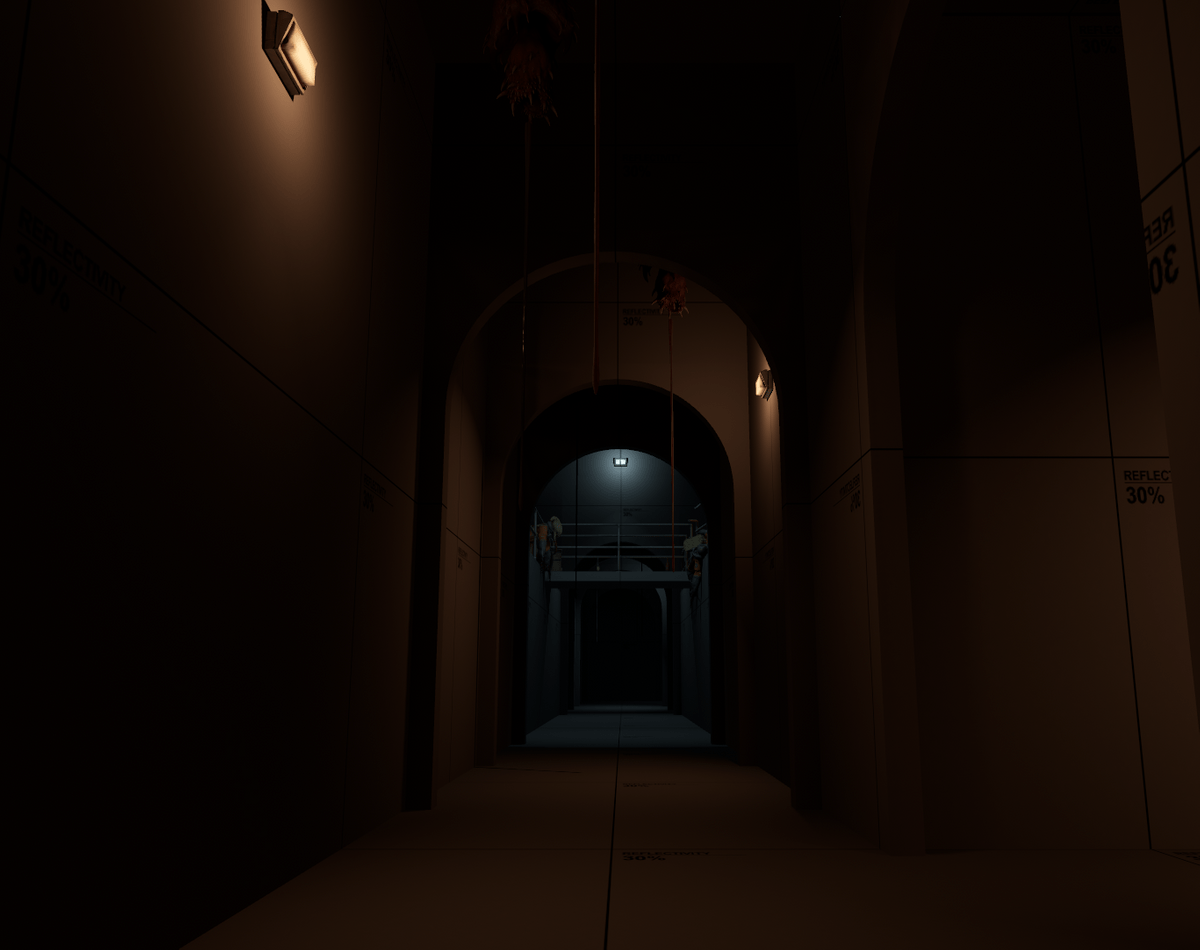
8. This also allowed for expanded gameplay and the inclusion of additional barnacles and zombies which the player needed to deal with before reaching the controls.
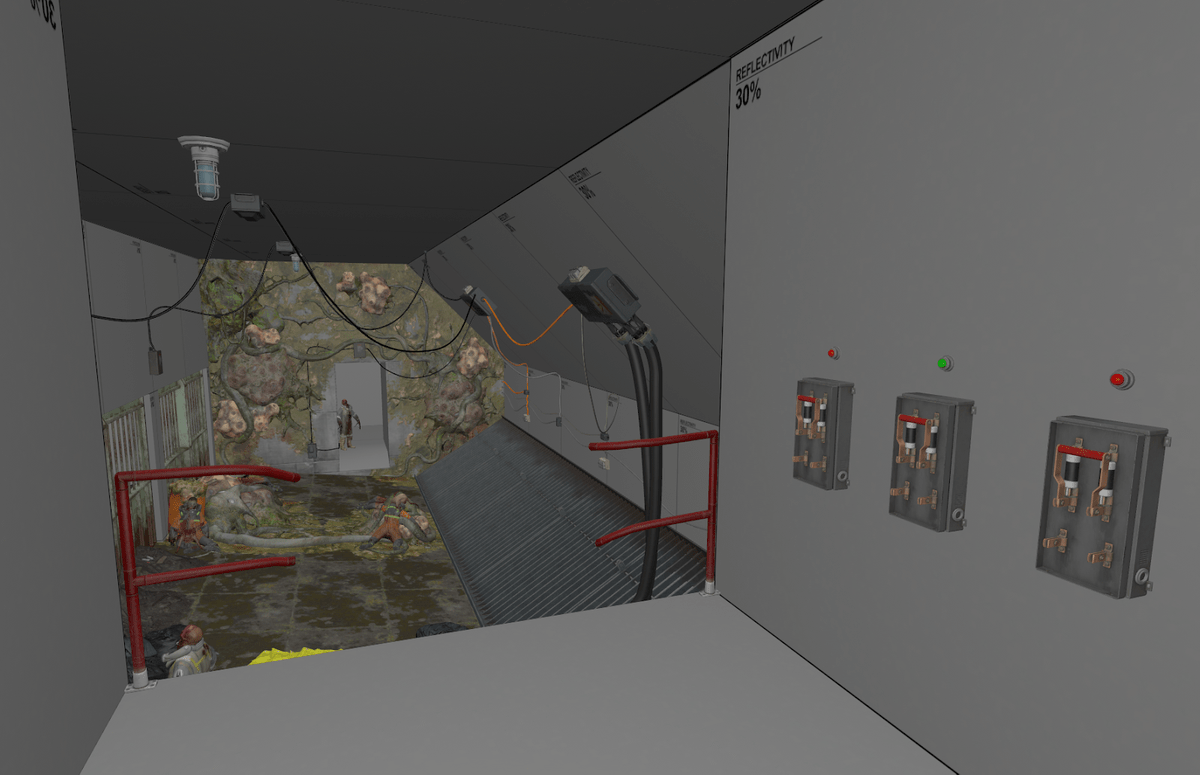
9. This solved two issues players experienced with the puzzle, which was the inability to monitor state changes of the puzzle or determine when the solution was reached
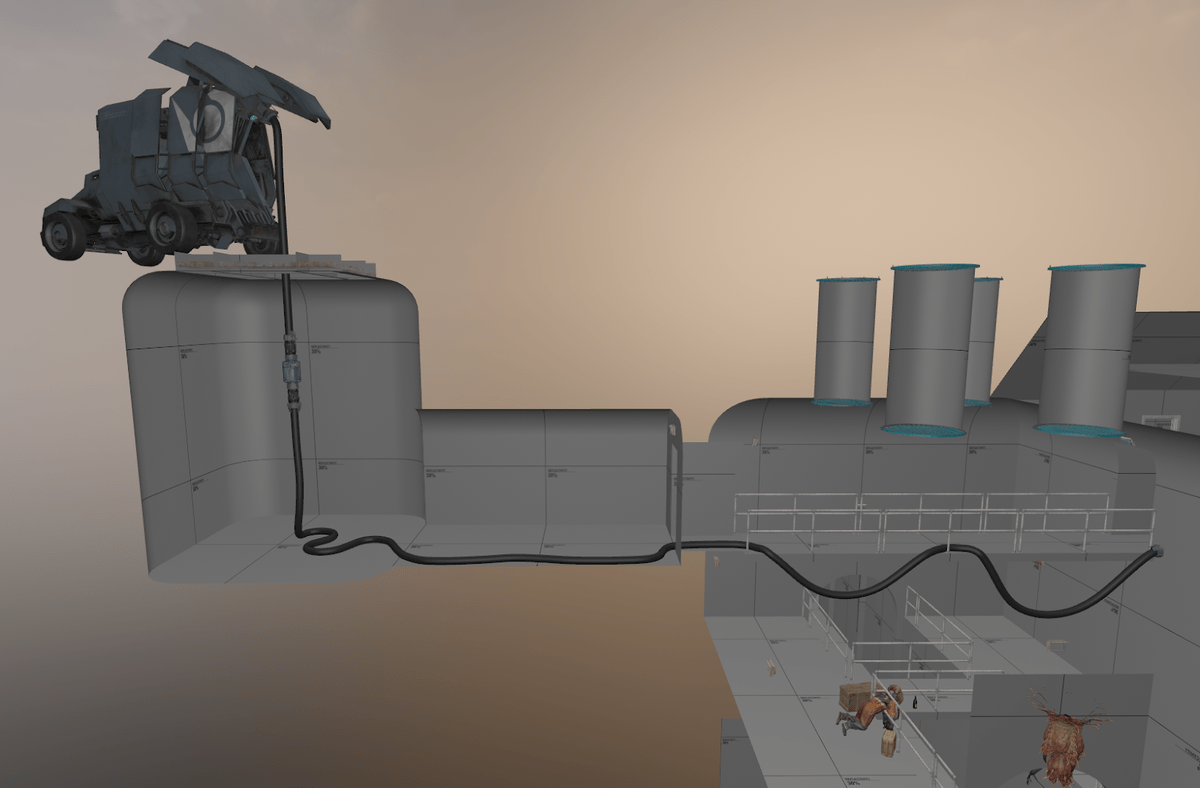
10. Lastly a significant change to the upper areas of the Lower Sewer was made with the introduction of the Truck and Conduit, which will be covered in their own section. Overall, the Lower Sewer serves as the first puzzle environment and allows the player to disable the first combine gate and progress to the Upper Atrium and Control Room.
The Fight
[SAMPLE]
The Upper Atrium
[SAMPLE]
The Control Room
[SAMPLE]
The Truck and Conduit
[SAMPLE]
Challenges, Shortcomings, and Solutions
[SAMPLE]
PART 3: BUILDING IT BIGGER AND BETTER
This part of the design document will cover the design of Storm Drain during its subsequent Alpha releases.
Expanding the Intro
[SAMPLE]
Creating the Topside
Adding the Sewer House
[SAMPLE]
Adding the Warehouse
[SAMPLE]
Challenges, Shortcomings, and Solutions
[SAMPLE]
PART 4: PUTTING IT ALL TOGETHER
This part of the design document will cover the design of Storm Drain's final Alpha release.
The Zombie Town
[SAMPLE]
Revisions to Sewer House
[SAMPLE]
The RESINance Cascade
[SAMPLE]
Tricky Tripwires
[SAMPLE]
The 3D Skybox
[SAMPLE]
Initial Audio Design and VO Inclusion
[SAMPLE]
Challenges, Shortcomings, and Solutions
[SAMPLE]
PART 5: THE GREAT ART PASS
This part of the design document will cover Storm Drain's initial art pass.
Environmental Art
[SAMPLE]
Optimization
[SAMPLE]
Challenges, Shortcomings, and Solutions
[SAMPLE]
PART 6: FINISHING TOUCHES AND TECHNICAL BITS
This part of the design document will cover the design of Storm Drain's Beta releases and Official Release.
Puzzle Revisions
During the initial Beta releases two of the major puzzles in the map, the Breaker Box Puzzle and the Steam Valve puzzle, both continued to confuse players due to their inconsistent or difficult to decipher messaging. Here is how I majorly reworked both of these puzzles in order to address these concerns, but also to improve on the player's VR experience with each puzzle.
Breaker Box Puzzle:
The old version of the breaker box puzzle was broken down into two steps, neither of which were very clear to players:
- Turn levers 1 and 2 ON on to overload the circuit.
- Turn lever 3 OFF to disable the remaining power.
This lead to many playtests where players would complete objective one, notice the state change then assume the puzzle was over. However upon proceeding to the electronically locked door, they would realize they still need to flip lever 3. I did not like this and felt like a total puzzle rework was necessary as the previous puzzle was a vestige from the earliest days of the level's development.
In order to address this issue, I made it so all levers work in coordination with one another to complete a single goal. An additional lever was added and the puzzle shifted from simply setting the positions of the levers (boring) to having to activate them in the proper sequence (more interesting). If a player failed to activate the levers in the correct sequence it would reset the puzzle and they would have to start over. This actually created a puzzle for the player to solve while simultaneously syncing up the state changes so that the player would not feel compelled to proceed unless they actually could. Furthermore lighting and signaling related to the breakers and the connections of the puzzle were added to help make it obvious what happened when the puzzle was complete.
Steam Valve Puzzle:
The prior steam valve puzzle introduced in the Sewer House had many issues with comprehension. This was due to a few main factors which included the fact that the puzzle controls and the puzzle result were disconnected by needing to traverse a ladder, but also that the "puzzle" could simply be solved by just turning all valves off. Thus I set out to not only make the puzzle more interesting for VR, but also to solve these issues with messaging the danger of the situation to the player. This was accomplished by:
- Implementing directional levers instead of circular levers and
- Adding labels and gauges which indicated the direction or presence of steam
- introducing the steam mechanic earlier in the level and with a less complex setup
Modifications to the hazard itself included increasing levels of penalty as the player moved into the volume, concluding with a fading teleport similar to when trying to traverse a rising zombie in other sections of HLA. Below is an example of the introductory steam puzzles which occur prior to reaching the Sewer House:
Later in the Sewer House, the concept of directional steam is introduced, or that the player may need to return the state of certain levers to previous positions in order to reach their ultimate goal. This is accomplished by making the player further obstruct their path in order to reach the final controls of the puzzle and having them work backwards reversing certain steps of their journey to clear the path fully. Below is a video showing part of this gameplay:
Combat Revisions
A complaint received from playtesters in earlier releases were that the combine engagements felt like shooting galleries. I tried to address this issue in the design of the fights by making the combine behavior less dictated by scripting and more dictated by their own decision making. In practice, this meant reducing the number of schedules, rules of engagement, and paths goals. Instead opting to let the actors make their own decisions with the available information to engage the player in effective ways. This was rather cumbersome as most of my fight logic was based on the same templates, but when the process was complete it lead to more dynamic fights where the AI wasn't so easily predicted in their pathing or styles of engagement. I also conducted an entire cover pass review of the map to allow more cover positions and places for the actors to engage from to bolster dynamic combat.
Audio: World Sounds, Soundscapes, and OpVars
A major complaint received by playtesters in the earliest beta versions of the level was that it sounded lifeless. This complaint made sense, because at the time the development goal of the art pass was to approach near finalized visuals. Up until this point, little focus had been placed on ambient sound design, with the majority of sound design resources being dedicated to combat music or interactive sounds that were triggered as part of a gameplay feedback mechanism. Therefore, I set out to bring the world to life with additional world sounds, custom soundscapes, and the deployment of OpVars to control Valve's new audio system present in HLA.
World Sounds:Various maps from the HLA campaign were analyzed to collect potential world sounds. In my opinion, this approach was much more efficient than simply browsing the soundevent viewer as it helped provide the necessary context of how these sounds were actually used in their respective environments. I used maps such as a2_headcrab_tunnel and a3_processing_plant as a good basis for gathering a mixture of sewer and industrial sounds, both of which would need to be included in Storm Drain for a convincing sounding environment. All these examples were collected into a Sound Zoo which I used during the audio design of Storm Drain to keep a convincing and cohesive set of environmental sounds together for use in the level.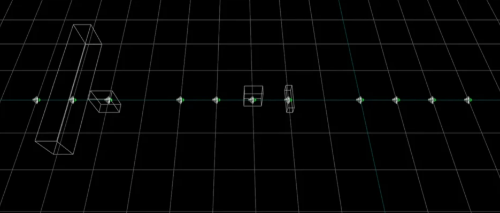
Sounds in the zoo were grouped by their relative type. In the example screenshot to the left you can see three distinct groups of sounds. The groups included in this photograph include ventilation sounds, electrical sounds, and Xen sounds. Organizing them as such allowed me to quickly populate the level with fitting sounds while still maintaining stylistic consistency of the world sounds used in the environment.
Soundscapes:
Early versions of Storm Drain included rudimentary use of soundscapes mainly as a form of audio filler. Meaning that their initial inclusion was merely to avoid the sensation of silence being perceived by the player. While this did the trick in the Alpha releases of Storm Drain, serious consideration was put into the eventual development of numerous custom soundscapes for use in the level. This allowed me the creative flexibility to have seamless transitions between soundscapes while maintaining the overall ambience, but still having finite control of the presence of specific sounds that should only be present in some of the level's environments such as buzzing flies or dripping water.OpVars:Half-Life: Alyx sounds phenomenal. I wanted Storm Drain to also sound phenomenal. However, in order to reach Valve levels of audio quality, you need to mingle with Valve levels of audio system overengineering. OpVars and their use is perhaps one of the more mystical aspects of HLA level design, insofar as very few people in the HLA development community could impart knowledge on the subject. Luckily I was able to scrounge up some pointers from my colleagues on the OpVar system used in HLA and began developing some audio test maps to help me understand and implement this feature in Storm Drain. Below are some screenshots of the example maps which were used to play with this system and understand its implementation:Map Versioning and Asset Reconciliation
After nearly two years of on and off development, Storm Drain needed a little tidying up behind the scenes. During the initial development of the project, all maps and submaps were versioned according to their release version. While this made for convenient archiving, it did not make for convenient versioning. Therefore towards the beta versions of the project all submaps were generically renamed and only the version of the base map changed throughout the remainder of the project.
In addition to map versioning, there were numerous cut assets still included in the project directory. Either models that were no longer used, materials that had been further modified, or any number of other artifacts of past versions. These were also evaluated during the beta stage of the project to reduce the overall file size of the project to the minimal amount. To say the least, it was successful considering the final version of the map was reduced by a few hundred megabytes when compared with prior versions.
Challenges, Shortcomings, and Solutions
Three major challenges existed during this phase of the development. Each is discussed below.
Sound Effects Not Playing:
During the initial development of the world sounds, I placed them without consideration to engine limits. This turned out to be a rather poor decision as multiple playtesters reported audio issues with certain sound effects refusing to play. The main culprit of this was the Rapid-fire which would almost sound like it was shooting in bursts instead of a constant stream of bullets. I figured this would be rather straight-forward to resolve and that I would simply need to reduce the number of sound events used in the world. Prior to acting on this assumption, I did some additional research into the official maps to determine what the typical number of sound events was on some of Valve's larger maps. My research informed me that this figure was between 100-200 sound events.
Using this as a target, I reduced the number of sound events included in Storm Drain's environment from the previous 300+ to a much cozier 170. Not only did this immediately resolve the audio issues reported by playtesters, it also optimized the the use of sound events in the level, removing many sounds which were completely inaudible due to their distance or placement.
AI Pathing Issues Part 2:
Once the atrium was redesigned to be swampy and full of cover, I wanted the combine to more actively use it in fights. However, the combine really didn't like going down the main ramp into the pit and would act odd when approaching the top of the hill. Initially, I figured this was because of an AI pathing issue that was preventing their animation graphs from maneuvering the space at the speed and angles I desired. Thus I invested some time in clipping the area and optimizing the geometry to generate a better navigation mesh:
Unfortunately, this did not actually solve the issue of them suddenly re-pathing at the top of the mound. After discussing with some colleagues what shenanigans the combine AI was up to, I discovered that it was actually an issue with the default max attack range which coincidentally was just far enough to engage the player from the top of the ramp. Therefore, the grunts would opt for the hard cover at the top rather than proceeding closer to the player. This was corrected by more finely tuning advanced ranges and max ranges of actors for each arena to ensure they were pressuring the player enough.
The Ending Train Dilemma:
In addition to these challenges and solutions, one frequented item of player feedback was left unresolved. This is regarding the ending train, which to the disappointment of players, still remains static. This was not because I was simply lazy, or ignoring feedback from players regarding this feature request, but because when considering the factors involved and engine limitations, I decided it would be an unwise investment of my time to develop a moving train. As a compromise, I increased the fidelity of the ending train's interior to give players a better sense of satisfaction upon reaching the conclusion of the level.
PART 7: INTERACTIVE OVERVIEW
Interact with the viewer to pan, zoom, and advance slides of Storm Drain's completed design.
PART 8: CONCLUSION
This part of the design document will cover my personal reflections about the project.
Reflections About the Project
Overall I am very satisfied with my time spent developing Storm Drain. It helped me become a more patient, organized, and mature level designer who understands that even though the creative process should be enjoyable, its still a monumental task to move a project alone. Working on this project helped me improve my craft tremendously and for that I am very thankful.
What did I learn?
The development was a highly educational and fulfilling experience for me. It pushed me to improve my skills as a developer, but also to understand that there are cost-benefit analyses to be conducted with ever decision along the path of a project. Here are some of the highlights of how Storm Drain improved my skills as a level designer:
Technical knowledge.Since Storm Drain was my first project with Source 2, there was a lot of ground to cover with respect to new features, capabilities, and workflows. This project helped me develop a firm understanding of the toolbox available to designers for HLA and helped me transition the way I approached the tools and workflows to better correspond with changes in technology and design principles. This include shaking off old-school design principles and restrictions that applied to BSP level creation and fully embracing the flexibility of modern tools and the environments they can create. I also enjoyed the ability to further organize and compartmentalize projects with the shift to map instances and selection sets.VR Level Design.Similar to my experience working with Source 2 for the first time, this was my first time working with VR level design. I don't want to say this was a case of "forget everything you know," but it certainly was a crash course in what really matters to the player experience when you switch from a mouse, keyboard, and traditional display to a HMD setup. During the beginning of the development of Storm Drain, many of the design principles that were originally implemented in the level were carried over from a flat-screen mentality. Understandably, this resulted in various aspects that are important to an engaging VR experience being initially overlooked. I sought to resolve these issues during my development.Scale:I had to adapt my perception of scale and flow to cater to VR design. For so long its been easy to think of a hallway as a 128x128x128uu box, but in VR this feels surprisingly large. I spent a lot of time studying Valve's levels to help establish better scale, placement of details, and engagement with the player as they progress through the environment in VR. However, there is a fine line between full and cluttered, and understanding the difference between creating an engaging space for players or a cumbersome space for players was something I had to feel out during the development of Storm Drain.Puzzles:I started reassessing how to communicate goals, progress, and messaging to the player in an immersive and intuitive fashion. This included thinking of where a player would look, what a player could touch, or how the player hears the environment around them. Initial drafts of puzzles were later replaced with experiences that catered to these senses. Additional sounds, haptic feedback, and effects go a long way in ensuring player comprehension in VR.Combat:Because combat mechanics greatly differ in VR, I had to reevaluate my approach to combat encounters. This included studying different cover positions, heights, and thicknesses to come to an understanding of how a battlefield is properly assembled in VR. At times it was tough to balance encounters to make sure they neither felt like assaults nor shooting galleries. In addition to considering how the player uses the environment to fight, considerations for the AI use of space became significantly more complicated than prior Half-Life titles. Later in my development of Storm Drain, my focus shifted from tightly controlling AI positions and objectives to creating environments with which the actors could make intelligible decisions that prompted dynamic play. Instead of ordering a soldier to take a position, I opted to let the actors decide their positions from a variety of different cover positions and routes to traverse and fight the player from.Compiling and evaluating playtester feedback to inform design decisions.Although I had past experiences collecting and evaluating playtester feedback for previous projects, Storm Drain was a whole different beast. Due to its iterative release, it was paramount that I meticulously organized and cataloged player feedback so that I could effectively work through the various suggestions, bugs, or other ideas or preferences the varied playtesters had. Two particular methods of organizing player feedback were used during my development of Storm Drain. Each is discussed below:By Subject Matter:During the early development of Storm Drain I often categorized player feedback regarding the subject matter of the feedback as the location of the bug or improvement. In earlier versions of the project this allowed me to focus on ironing out the local issues of different areas of the level and improve upon them.By Complexity:During the later development of Storm Drain I often categorized player feedback by perceived complexity to resolve. This was a tonal shift as the project entered its later stages where I wanted to evaluate the cost-impact of time to resolve any particular suggestion or issue with the design of the level. This process was very useful in prioritizing my design efforts to address concerns in the most efficient way possible.What would I do differently?
Looking back on this project, I would probably change the following aspects to mitigate personal and development frustrations:
Carefully manage my expectations and ambitions.A big frustration with the development of Storm Drain was managing my expectations for the project and ambitions for its scope. Feature creep became a serious concern with the development of Storm Drain. I often found myself having to step back and take a look at the overall plan and design of the level in order to make tactical decisions on where my limited resources could be spent. If I was to restart the development of The Storm Drain, I would likely opt to create a concise experience that explored a more limited environment. It was not my original intention to create a nearly hour long VR experience.Release it when its done, not iteratively.Since Storm Drain was released iteratively on the workshop throughout its development, it was harder to garner a sense of significant achievement when the dust finally settled. This isn't to say that the input throughout the iterative release cycle was not extremely valuable in both encouraging me to continue developing the project, but also refining it every step along the way. However, this didn't play well with the workshop algorithm and I would have anticipated a much larger audience reaction to its release had it not been done iteratively.Design something better suited to VR performance limitations.Storm Drain is an extremely open and dense environment. VR and VVIS do not typically handle such environments with grace, so extra effort had to be put into the culling and control of visboxes to create a performant experience. Reflecting back on the design of the level, it would have likely been easier to craft an experience that was more cooperative with VR and VVIS. I was able to get the performance in check, but at the cost of time that could have been otherwise used developing other areas of the project. All this being said, I think part of what makes Storm Drain uniquely impressive is that its design is not other levels due to the factors noted above.Special Thanks
Special thanks on this project goes out to the following folks whose support and encouragement made this an extremely fulfilling experience:
Maarten 'Marnamai' Frooninckx.
Thank you for your time discussing practically all facets of this project. I knew when I needed a second set of eyes or another opinion about a design change or an idea, that you were a dependable sounding board. I know Storm Drain would not have reached the level of polish it is at without the numerous conversations we had throughout its development. Furthermore I would like to thank you for imparting your expertise as a level designer and helping me improve my design process and routines for successful project management.
Abraham 'iohnnyboy' Lee.
Thank you for helping me develop and master VR combat and combine AI interactions with the player. Your extensive research into combine AI helped me tremendously in polishing and redesigning my combat encounters to feel more dynamic and engaging.
Gunnar 'G Kaf' Kafel.
Thank you for your assistance with numerous technical questions regarding the development of the map including assistance developing custom animation graphs so my combine could ride elevators without having a seizure.
Beauman 'Beaumancer' Edwards.
Thank you for providing your expertise on sound events and OpVars. Many of the custom sounds and effects in Storm Drain were successful because of your assistance.
Skummeh.
Thank you for your various playtests and support. Without critical feedback from playtesters such as yourself, I wouldn't have been able to address certain issues and polish the map to this extent.
Have a question about Storm Drain or my level design process? Feel free to contact me with the button below:













































